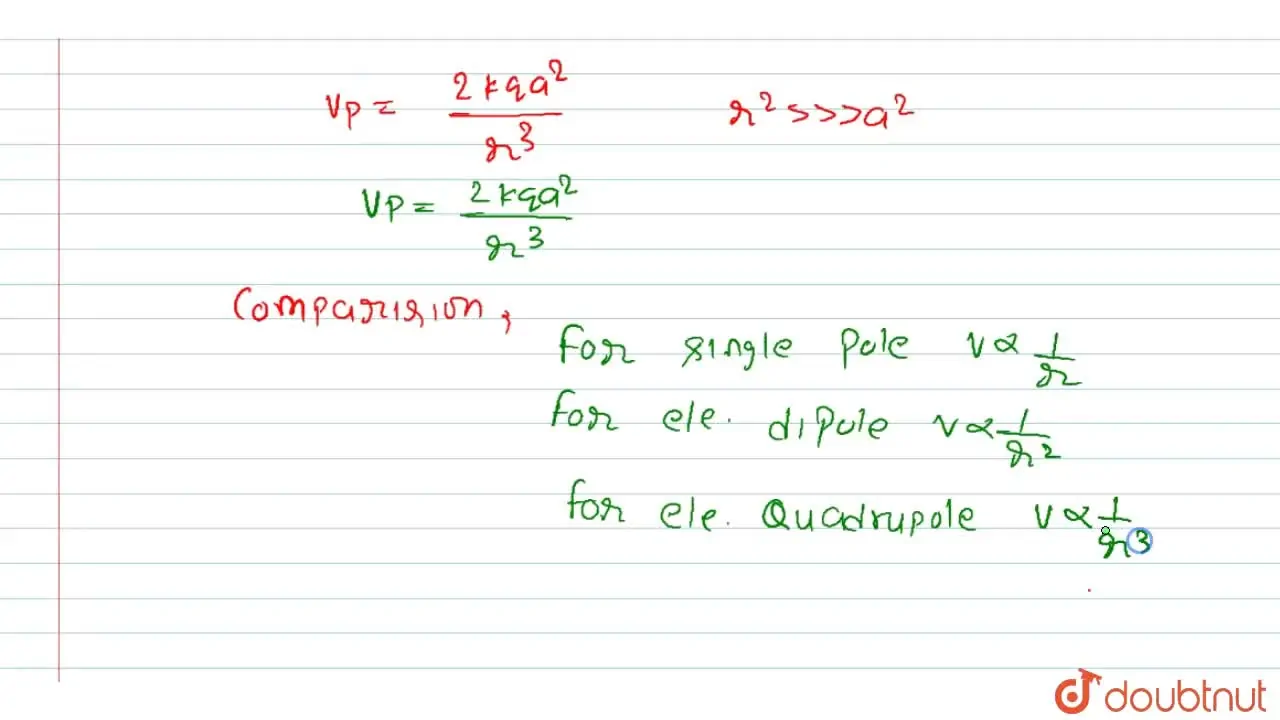Fig shows a charge array known as an 'electric quadrupole'. For a point on the axis of the quadrupole, obtain the dependence of potential on r for r/a>>1, and contract your results with that due to an electric dipole and an electric monopole (i.e, a single charge).

Four charges of same magnitude are placed at points X, Y, Y and Z respectively, as shown in the following figure.

A point is located at P, Which is r distance away from point Y.
The system of charges forms an electric quadrupole.
It can be considered that the system of the electric quadrupole has three charges.
Charge +q placed at point X
Charge −2q placed at point Y
Charge +q placed at point Z
XY=YZ=a
YP=r
PX=r+a
Electrostatic potential caused by the system of three charges at point P is given by,
V=14π∈0[qXP−2qYP+qZP]
=14π∈0[qr+a−2qr+ar−a]
=Q4π∈0[r(r−a)−2(r+a)(r−a)+r(r+a)r(r+a)(r−a)]
=q4π∈0[r2−ra−2r2+2a2+r2+rar(r2−a2)]=q4π∈0[2a2r(r2−a2)]
=2qa24π∈0r3(1−a2r2)
Since ra>>1
∴ar<<1
a2r2 is taken as negligible.
∴V=2qa24π∈0r3
It can be inferred that potential, V∝1r3
However, it is known that for a diople, V∝1r3
And , for a monopole, V∝1r
Related Playlists
- BOOK - NCERT ENGLISHCHAPTER - ELECTROSTATIC POTENTIAL AND CAPACITANCEEXERCISE - Exercise37videos
ELECTROSTATIC POTENTIAL AND CAPACITANCE
- BOOK - NCERT ENGLISHCHAPTER - ELECTROMAGNETIC WAVESEXERCISE - Exercise15videos
ELECTROMAGNETIC WAVES
- BOOK - NCERT ENGLISHCHAPTER - MAGNETISM AND MATTEREXERCISE - Exercise25videos
MAGNETISM AND MATTER
Similar Questions
Figure shows a charge array known as an "electric quadrupole". For a point on the axis of the quadruple, the dependence of potential on r(ra>>1) is 1rn. Find n?
 View Solution
View SolutionDraw a plot showing the variation of (i) electric field (E ) and (ii) electric potential (V) with distance r due to a point charge Q.
View SolutionElectric field intensity (E) due to an electric dipole varies with distance (r ) from the point of the center of dipole as :
View Solution(i) Derive the expression for the specific for the electric potential due to an electric dipole at a point on its axial line.
(ii) Depiet the equivpotential surfaces due to an electric dipole.View SolutionA circular coil of radius R carries an electric current. The magnetic field due to the coil at a point on the axis of the coil located at a distance r from the centre of the coil, such that r>>R, varies as
View SolutionA circular coil of radius R carries an electric current. The magnetic field due to the coil at a point on the axis of the coil located at a distance r from the centre of the coil, such that r>>R, varies as
View SolutionThe potential at a point due to an electric dipole will be maximum and minimum when the angles between the axis of the dipole and the line joining the point to the dipole are respectively
View SolutionTwo charges e and 3e are placed at a distance r. The distance of the point where the electric field intensity will be zero is
View SolutionIntensity of an electric field (E) depends on distance r due to a dipole, is related as
View SolutionObtain an expression for electric potential .V due to a point charge .Q at a distance r.
View Solution


